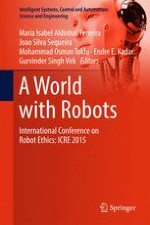This book contains the Proceedings of the International Conference on Robot Ethics, held in Lisbon on October 23 and 24, 2015. The conference provided a multidisciplinary forum for discussing central and evolving issues concerning safety and ethics that have arisen in various contexts where robotic technologies are being applied. The papers are intended to promote the formulation of more precise safety standards and ethical frameworks for the rapidly changing field of robotic applications. The conference was held at Pavilhão do Conhecimento/Ciência Viva in Lisbon and brought together leading researchers and industry representatives, promoting a dialogue that combines different perspectives and experiences to arrive at viable solutions for ethical problems in the context of robotics.
The conference topics included but were not limited to emerging ethical, safety, legal and societal problems in the following domains:
• Service/Social Robots: Robots performing tasks in human environments and involving close human-robot interactions in everyday households; robots for education and entertainment; and robots employed in elderly and other care applications
• Mobile Robots: Self-driving vehicles, autonomous aircraft, trains, cars and drones
• Robots used in medicine and for therapeutic purposes
• Robots used in surveillance and military functions
